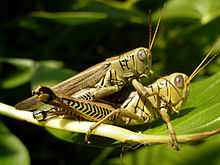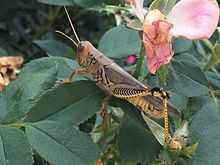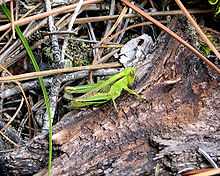Differential grasshopper
| Differential grasshopper | |
|---|---|
 | |
| Differential grasshoppers copulating | |
| Scientific classification | |
| Kingdom: | Animalia |
| Phylum: | Arthropoda |
| Class: | Insecta |
| Order: | Orthoptera |
| Family: | Acrididae |
| Subfamily: | Melanoplinae |
| Genus: | Melanoplus |
| Species: | M. differentialis |
| Binomial name | |
| Melanoplus differentialis (Thomas, 1865)[1] | |
| Subspecies | |
| |
The differential grasshopper (Melanoplus differentialis) is a species of grasshopper belonging to the genus Melanoplus found throughout northern Mexico, central United States[2] and southern Ontario, Canada.[3] It is considered a pest in most of its range.[2]
Description
Adult males grow to 28–37 mm and females grow to 34–50 mm. They are brownish or greenish and as they age the color will darken. Some nymphs can be bright yellow. There are black grooves on the pronotum. The male has bootlike appendages at the end of its abdominal tip.[4] There are inverted chevrons along the hind femur and the hind part the tibia is yellowish with black spikes. All of the adults tarsi are yellow along with its antennae, which in some cases are reddish yellow.[5]
Range and habitat
Found throughout most of the United States except for the east coast and northwest.[6] Within its range the M. differentialis is most often found in heavily weeded areas and grasslands, they can even be spotted in vacant lots and other urban areas.[7] This species is not migratory but can travel within a few miles to search for food.
Life cycle

An adult female will lay up to 8 egg masses in soft soil, each of these masses can contain up to 11 eggs. Once these eggs are laid about 54% of them will hatch in about 2 weeks. There is only one generation a year which occurs in early summer. Once they hatch the nymphs take around 32 days to become complete adults. Adults are most active during the summer while the larvae are active in the spring. It is polyphagous, eating both grasses and forbs but experiments have shown that they grow faster if fed forbs. The most favored food plants tend to be Giant ragweed (Ambrosia trifida), Common sunflower (Helianthus annuus), Prickly lettuce (Lactuca serriola). Adults can pick up on a chemical change in wilted lettuce and sunflowers and will tend to avoid these plants.
Agricultural problems
The young will feed upon various grains, alfalfa and hay crops while the adults will attack the corn, cotton and deciduous fruit crops. A single swarm can often deplete a younger crop to nothing in a matter of a few days. Because this species has a tendency to stay in large swarms while eating, it is a serious issue for farmers in most of its range. In the northern part of the range it is joined equally in numbers by the Two-striped grasshopper (Melanoplus bivittatus) but it strongly out numbers it in the southern portion.[8]
References
- ↑ "ITIS Standard Report Page: Melanoplus differentialis". Retrieved 2009-02-04.
- ↑ 2.0 2.1 Grasshoppers
- ↑ Orthoptera, Ojibway Nature Centre
- ↑ Evans, Arthur V. (2007). "Grasshopper, Crickets, and Katydids: Order Orthoptera". Field Guide to Insects and Spiders of North America. Sterling Publishing Co., Inc. p. 94. ISBN 978-1-4027-4153-1.
- ↑ Knopf, Milne & Milne (1986). "Grasshopper and Crickets". National Audubon Society Field Guide to North America Insects & Spiders. Alfred A. Knopf , Inc. p. 421. ISBN 0-394-50763-0.
- ↑ "Species Melanoplus differentialis - Differential Grasshopper - BugGuide.Net". Retrieved 2009-02-04.
- ↑ Kaufman, Kenn; Eaton, Eric R. (2007). "Grasshoppers". Kaufman Field Guide to Insects of North America. Houghton Mifflin Books. pp. 74–75. ISBN 978-0-618-15310-7.
- ↑ "Melanoplus differentialis fact sheet". Retrieved 2009-02-04.
External links
| External identifiers for Melanoplus differentialis | |
|---|---|
| Encyclopedia of Life | 500112 |
| Also found in: Wikispecies | |
| Wikimedia Commons has media related to Melanoplus differentialis. |
- Melanoplus differentialis, Univ. of Wyoming
- Melanoplus differentialis, Discover Life
- Orthoptera (grasshoppers, katydids, crickets) of Ojibway, Ojibway Nature Centre
